Geo-environmental Risk Research Group
JapaneseAssessment of Potential Risk Associated with Heavy Metals in Tsunami Sediments
The Great East Japan Earthquake unleashed a giant tsunami that led to the loss of thousands of lives, triggered the Fukushima Daiichi Nuclear Power Plant Accident, and induced a huge amount of Tsunami sediments. These tsunami sediments deposited along coastal areas in 6 prefectures and were considered to be hazardous because multiple heavy metal pollutions may exist.
To characterize the chemical properties of tsunami sediments and to quantitatively evaluate potential risk that may be induced by tsunami sediments, an urgent survey was performed.
More than 130 samples were taken from the coastal areas of Aomori, Iwate, Miyagi, Fukushima, Ibaraki and Chiba prefectures. Standard tests were performed to evaluate the leaching and total concentrations of toxic heavy metals such as Arsenic (As), Lead (Pb), Cadmium (Cd), Chromium (Cr) and Copper (Cu) within the tsunami sediments. These results were than used to evaluate potential risk by assuming that major pathways of human exposure are intake of groundwater and ingestion of soil particles.
Our findings illustrated that although leaching values of arsenic and lead exceeded environmental criteria at a few points, their risk levels to human health were not so much high. Tsunami sediments can be used for restoration works such as construction materials for road base when necessary improvements are performed. The findings also provide basic information for developing strategies for risk mitigation and risk reduction associated with the treatment of tsunami sediments.
The leaching value of arsenic and risk levels for the tsunami sediments in Miyagi coastal area are shown below as an example.
.png)
Leaching value of arsenic (Ieft) and risk levels (right) for the tsunami sediments in the Miyagi coastal area as an example
The results were widely presented including an original paper which won the 2012 best paper award from the Japan Society of Civil Engineers.

The 2012 best paper award from the Japan Society of Civil Engineers





